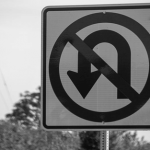While this winter has been a much nicer winter temperature wise, I can’t help but notice how much more fog there seems to be this winter than in a typical colder winter. While driving in fog creates more danger for all drivers no matter the type of vehicle, for commercial motor vehicles (like semis) the dangers posed are often catastrophic for other motorists on the road. That is why commercial motor vehicles have different rules for operating in fog than drivers of cars.
Federal Law
If you have read prior blogs (here and here) we have previously written about the rules applicable to commercial motor vehicles. Specifically, we discussed 49 CFR §392.14, which states:
Extreme caution in the operation of a commercial motor vehicle shall be exercised when hazardous conditions, such as those caused by snow, ice, sleet, fog, mist, rain, dust, or smoke, adversely affect visibility or traction. Speed shall be reduced when such conditions exist. If conditions become sufficiently dangerous, the operation of the commercial motor vehicle shall be discontinued and shall not be resumed until the commercial motor vehicle can be safely operated. Whenever compliance with the foregoing provisions of this rule increases hazard to passengers, the commercial motor vehicle may be operated to the nearest point at which the safety of passengers is assured.
As stated in the law, fog is a specific hazardous condition that requires extreme caution in the operation of a commercial motor vehicle like a semi. At a minimum, this law states that speed needs to be reduced. However, the law is also clear that if conditions become sufficiently dangerous, operation needs to be discontinued until it is safe to drive again.
In addition to the Federal rule on this issue, the State of North Dakota has specific training for drivers who are testing to get their CDL (commercial drivers license) in North Dakota.
North Dakota CDL Manual
To successfully obtain a CDL in North Dakota, the State has a book for test takers to study called the Commercial Drivers License Manual (“ND CDL Manual”). This manual is compliant with the Commercial Motor Vehicle Safety Act related to “minimum testing standards for the licensing of commercial drivers”. So, the rules set forth in the CDL Manual in North Dakota are the minimum standards.
Section 2.12 in ND CDL Manual is titled “Driving in Fog”, and states:
Fog can occur at any time. Fog on highways can be extremely dangerous. Fog is often unexpected, and visibility can deteriorate rapidly. You should watch for foggy conditions and be ready to reduce your speed. Do not assume that the fog will thin out after you enter it. The best advice for driving in fog is don’t. It is preferable that you pull off the road into a rest area or truck stop until visibility is better. If you must drive, be sure to consider the following:
- Obey all fog-related warning signs.
- Slow down before you enter fog.
- Use low-beam headlights and fog lights for best visibility even in daytime, and be alert for other drivers who may have forgotten to turn on their lights.
- Turn on your 4-way flashers. This will give vehicles approaching you from behind a quicker opportunity to notice your vehicle.
- Watch for vehicles on the side of the roadway. Seeing taillights or headlights in front of you may not be a true indication of where the road is ahead of you. The vehicle may not be on the road at all.
- Use roadside highway reflectors as guides to determine how the road may curve ahead of you.
- Listen for traffic you cannot see.
- Avoid passing other vehicles.
- Don’t stop along the side of the road, unless absolutely necessary.
Catastrophic Fog Crash Examples
As stated in Section 2.12, “the best advice for driving in fog is don’t” when talking about commercial motor vehicles. This is important advice for many reasons. The following are two examples of why commercial motor vehicles and fog should not mix:
- A commercial motor vehicle takes longer to stop and react to issues with traffic in ideal weather and road conditions. Adding fog to this equation only increases the risk the commercial motor vehicle will not be able to react and stop in a safe manner. If a commercial motor vehicle cannot safely stop in time, the results are catastrophic and oftentimes involve death to drivers and passengers in other smaller vehicles.
- For commercial motor vehicles attempting to turn across lanes of highway travel to enter the highway, it takes longer for their trailers to clear the lane of travel. In fog, the commercial motor vehicle driver can’t see far enough down the roadway for approaching traffic to make sure it’s clear to allow sufficient time to clear the lanes. Also, drivers traveling down the highway are unable to see the trailer in their lane until it is too late to stop. When a regular car runs into a trailer broadside, it often creates an underride of the car into the bottom of the trailer, as the frame and bumpers of the car don’t match up with the side structure of the trailer. This type of crash is often a catastrophic situation for the driver and passengers of the car.
Conclusion
As has been said multiple times before on this blog, we have a deep respect for the trucking industry and fully understand that without trucking, most (if not all) of the things we use day-to-day in our houses, work, and personal life would not be available. At the same time, our team has sat in the living rooms of too many families who have endured tremendous loss because a loved one has been killed or catastrophically injured when a truck driver (or more often the company they work for) decided safety was not a priority. Our hope is one day our team never has to visit another family in their home to discuss the death or catastrophic injury of their loved one and that safety ultimately prevails as a top priority. Until then, we understand the importance of taking unsafe behavior to task through a lawsuit to hopefully save the next person and family from a tremendous loss.
This area of the law is highly technical and it is important you have an attorney who understands the huge difference between a regular car crash and one involving a commercial motor vehicle. If you or a loved one has been catastrophically injured or killed in an accident involving a commercial motor vehicle, it is very important you hire an attorney who knows trucking law and regulations. Our Personal Injury Team at SW&L Attorneys understands, knows, and handles all trucking and commercial motor vehicle accidents. To get in touch with our team, call 701-297-2890, or email us via the contact form below.










